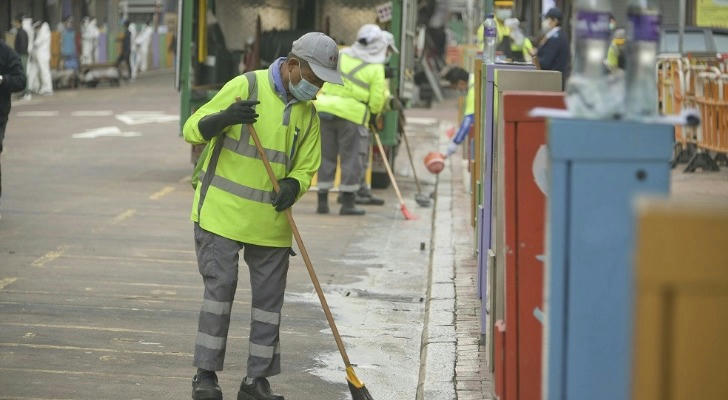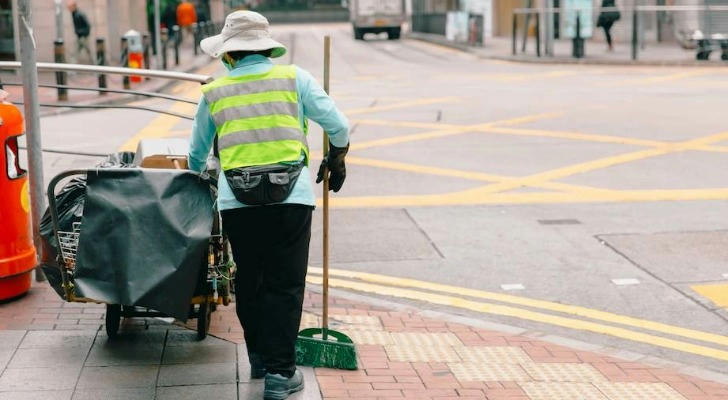City Beauticians: Unveiling the Daily Life of Sanitation Workers

Let’s take a look at the daily work of a cleaner!
I. Introduction Sanitation workers are the guardians of the urban environment. Through their daily cleaning tasks, they maintain the cleanliness of streets, reduce pollution, and enhance the image of the city. Their hard work is directly related to the health and quality of life of residents and is an indispensable part of the city's operation.
II. Daily Work of Sanitation Workers The typical workday of a sanitation worker usually starts at dawn. They are fully equipped, moving through the city's streets and alleys. They are responsible for sweeping streets, collecting garbage, and cleaning public facilities to ensure the cleanliness and hygiene of the urban environment. Their work includes using brooms, garbage trucks, and other tools to clean up garbage, sometimes dealing with special stains or waste. Their work is not affected by weather conditions, often carried out in adverse weather to maintain the cleanliness and beauty of the city.
III. Main Tasks and Responsibilities of Sanitation Workers Sanitation workers bear the important task of maintaining the cleanliness and hygiene of the city. Their main responsibilities include sweeping streets, collecting and sorting garbage, and cleaning public facilities such as parks and squares. They also ensure that garbage is processed in a timely manner to prevent pollution and disease transmission. In addition, sanitation workers are responsible for supervising and maintaining clean areas to ensure the continuous cleanliness of the environment, providing a comfortable and hygienic urban space for residents and visitors.

IV. Tools and Equipment Used by Sanitation Workers Sanitation workers use a range of professional tools and equipment to perform their work. These tools include brooms, dustpans, garbage grabbers, garbage bags, mops, buckets, high-pressure water guns, garbage trucks, and recycling bins. They may also use electric or manual sweepers to improve efficiency. In some cases, sanitation workers also use special cleaning agents and disinfectants to remove stubborn stains and kill bacteria. In addition, personal protective equipment such as gloves, masks, safety helmets, and reflective vests are also indispensable parts of their work to ensure safety during task execution. With the development of technology, some sanitation workers have also begun to use smart devices, such as GPS trackers and mobile applications, to optimize routes and improve work efficiency.
V. Common Problems Faced by Sanitation Workers in Their Duties Sanitation workers often face a variety of challenges in their duties. First, they need to cope with adverse weather conditions, such as heavy rain, high temperatures, or cold, which not only affect work efficiency but also pose a threat to their health. Second, sanitation workers often have to deal with dangerous or harmful waste, such as broken glass, needles, or chemicals, which requires them to have certain safety knowledge and protective measures.
In addition, sanitation workers may also face disrespect and neglect from the public, and their work is often underestimated and lacks social recognition. They may also encounter problems of insufficient resources, such as the lack or aging of cleaning tools and equipment, which limits their work effectiveness. In some areas, sanitation workers may also face long working hours, low wages, and insufficient benefits, which affect their work motivation and quality of life. Finally, with the acceleration of urbanization, the increase in the amount of garbage also brings greater work pressure to sanitation workers.

VI. Solutions to Some Problems Encountered by Sanitation Workers at Work
- Improve working conditions: Provide appropriate personal protective equipment to ensure the safety of sanitation workers when handling dangerous waste.
- Raise public awareness: Through education and publicity activities, raise public awareness of the importance of sanitation workers' work and encourage respect and support for sanitation workers.
- Provide training and education: Provide professional training for sanitation workers, including safe operation, health protection, and the use of new technologies, to improve their work efficiency and self-protection ability.
- Improve compensation and benefits: Ensure that sanitation workers receive fair compensation and appropriate benefits to improve their job satisfaction and quality of life.
- Optimize resource allocation: Ensure that cleaning tools and equipment are sufficient and updated to improve cleaning efficiency and quality.
- Policy support: The government can support the work of sanitation workers by formulating relevant policies, such as providing job security, improving the working environment, and providing necessary financial support.
- Technological application: Use modern technology, such as automated cleaning equipment and intelligent management systems, to reduce the physical labor of sanitation workers and improve work efficiency.
- Community participation: Encourage community members to participate in cleaning activities, share the burden of sanitation workers, and enhance community cohesion. Through these measures, the problems encountered by sanitation workers in the performance of their duties can be effectively solved, and their working conditions and quality of life can be improved.
VII. Case Analysis Adam is a sanitation worker in the city center area, and his daily work is full of challenges and responsibilities. Every morning, he arrives at his post before the first ray of sunlight appears, starting his daily cleaning tasks. He first checks the trash cans on the street and loads the overflowing garbage bags into the garbage truck. Then, he uses a broom and dustpan to sweep the sidewalks, making sure no corners are missed. Before the peak hours, Adam also quickly cleans public areas to welcome the flow of people for the day. His work is not limited to sweeping; it also includes using disinfectants to clean park benches and children's playground equipment to ensure public health. Despite the hard work, Adam is well aware that his efforts are crucial for maintaining the cleanliness of the city and the quality of life of residents.
Adam has encountered a series of challenges in his work, but he has overcome these difficulties in the following ways:
- Adverse weather: In the cold winter or hot summer, Adam has to work in extreme weather conditions. To overcome this challenge, he wears appropriate work clothes, such as cold-resistant clothes or sun protection equipment, and ensures regular hydration to maintain health and safety.
- Dangerous items: When cleaning up garbage, Adam may encounter sharp items or hazardous materials. He handles these items by wearing protective gloves and using the right tools to ensure his safety.
- Public disrespect: Sometimes, Adam encounters a lack of understanding or disrespect from the public. To deal with this situation, he maintains a professional attitude and raises awareness of the importance of sanitation work through community education activities.
- Resource limitations: With limited resources, Adam needs to use tools and equipment creatively. He maintains existing tools to ensure they are in good condition and shares resources with colleagues to improve work efficiency.
- Heavy workload: With the increase in urban garbage, Adam faces tremendous work pressure. He improves efficiency by optimizing work routes and time management, and he also advocates for community members to participate in cleaning activities to share the responsibility.
- Technological challenges: With the continuous advancement of cleaning technology, Adam needs to continuously learn and adapt to new technologies. He improves his skills by attending training courses and seminars to better utilize modern cleaning tools.
- Social recognition: The work of sanitation workers is often not fully recognized. Adam improves public respect for this profession by participating in community activities and volunteer services, demonstrating the contribution of sanitation workers to society. Through these methods, Adam not only overcomes the challenges in his work but also improves his job satisfaction and makes a positive contribution to the cleanliness and beauty of the city.
VIII. Conclusion Sanitation workers are an indispensable part of urban life. They maintain the cleanliness of streets and public spaces, ensuring the health of residents and the beauty of the city. Their hard work helps to reduce the spread of diseases, enhance the city's image, and provide residents with a comfortable and safe living environment.
